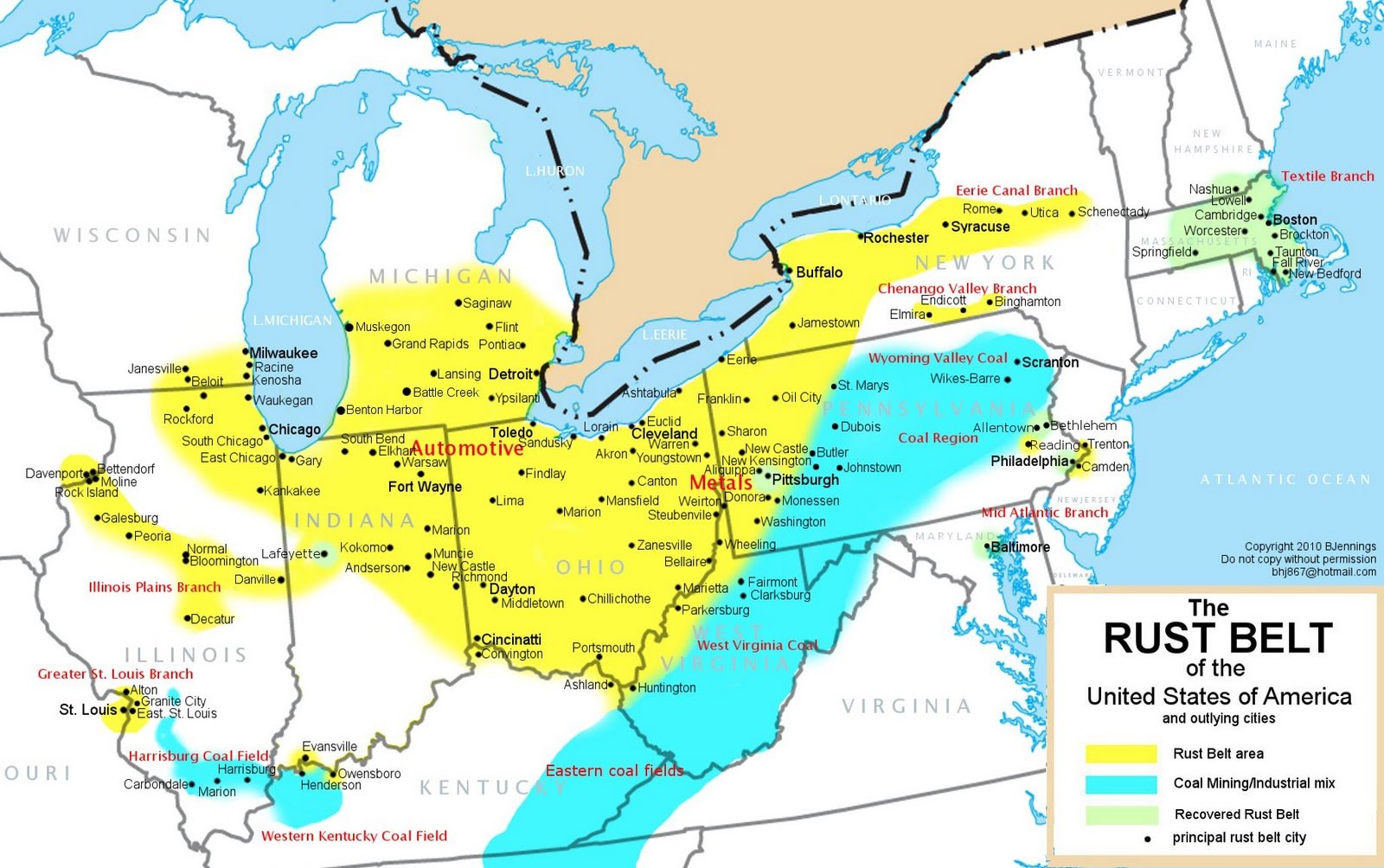
What is the Rust Belt? The Rust Belt refers to a region in the northeastern and midwestern United States known for its once-thriving industrial sector. This area, stretching from New York through Pennsylvania, Ohio, Indiana, and Michigan, was a powerhouse of manufacturing, particularly steel production, automotive, and other heavy industries. However, starting in the mid-20th century, these industries began to decline due to factors like globalization, automation, and shifts in economic policy. This led to significant job losses, population decline, and urban decay. Despite these challenges, the Rust Belt remains a vital part of America's history and economy, with ongoing efforts to revitalize and reinvent these communities.
Key Takeaways:
- The Rust Belt was once a thriving industrial region, but faced economic decline. Efforts to revitalize it include technology investments and urban farming, showing signs of renewal and transformation.
- Notable figures like Thomas Edison and LeBron James hail from the Rust Belt. Each city has its own unique story, from Detroit's automobile history to Cleveland's pioneering use of electricity.
What is the Rust Belt?
The Rust Belt refers to a region in the northeastern and midwestern United States known for its industrial history. Once a booming hub of manufacturing, it has faced economic decline and population loss in recent decades. Let's dive into some fascinating facts about this region.
-
The term "Rust Belt" was popularized in the 1980s to describe the economic decline, population loss, and urban decay due to the shrinking of its once-powerful industrial sector.
-
Major cities in the Rust Belt include Detroit, Cleveland, Pittsburgh, Buffalo, and Milwaukee.
-
The region was once known as the "Steel Belt" due to its dominance in steel production.
-
The decline began in the late 20th century as industries moved overseas for cheaper labor and production costs.
Historical Significance of the Rust Belt
The Rust Belt played a crucial role in the industrialization of the United States. Its factories and mills were the backbone of American manufacturing.
-
During World War II, the Rust Belt was essential for producing war materials, earning it the nickname "Arsenal of Democracy."
-
The Erie Canal, completed in 1825, was a significant factor in the region's early industrial growth.
-
The Great Lakes provided a natural transportation network for raw materials and finished goods.
-
Immigrants from Europe flocked to the Rust Belt in the late 19th and early 20th centuries, seeking jobs in its factories.
Economic Impact of the Rust Belt
The economic contributions of the Rust Belt were immense, but its decline has had lasting effects on the region and the country.
-
At its peak, the Rust Belt produced more than half of the nation's steel.
-
The decline of the auto industry in Detroit led to a significant economic downturn in the city.
-
Many Rust Belt cities have struggled with high unemployment rates and poverty levels.
-
Efforts to revitalize the region have included investments in technology, education, and infrastructure.
Cultural Influence of the Rust Belt
The Rust Belt's cultural impact is evident in its music, sports, and community spirit.
-
The region is known for its contributions to rock and roll, with Cleveland being home to the Rock and Roll Hall of Fame.
-
Pittsburgh is famous for its sports teams, including the Steelers, Penguins, and Pirates.
-
The Rust Belt has a rich tradition of blue-collar work ethic and community pride.
-
Many iconic American foods, such as Buffalo wings and Detroit-style pizza, originated in the Rust Belt.
Environmental Challenges in the Rust Belt
Industrial activities have left a significant environmental footprint on the Rust Belt, leading to various challenges.
-
Pollution from factories has contaminated air and water sources in many areas.
-
The Great Lakes have faced issues with industrial waste and invasive species.
-
Efforts to clean up and restore the environment have been ongoing, with mixed results.
-
Brownfield sites, or abandoned industrial properties, are common in the Rust Belt and pose redevelopment challenges.
The Future of the Rust Belt
Despite its challenges, the Rust Belt is showing signs of renewal and transformation.
-
Some cities, like Pittsburgh, have successfully transitioned to technology and healthcare industries.
-
Young entrepreneurs are investing in Rust Belt cities, attracted by affordable real estate and a sense of community.
-
Urban farming and green spaces are becoming more common in efforts to revitalize neighborhoods.
-
The region's rich history and unique architecture are drawing tourists and new residents.
Notable People from the Rust Belt
The Rust Belt has produced many influential figures in various fields.
-
Thomas Edison, the famous inventor, was born in Milan, Ohio.
-
LeBron James, one of the greatest basketball players of all time, hails from Akron, Ohio.
-
Michael Moore, the documentary filmmaker, grew up in Flint, Michigan.
-
Gloria Steinem, a leading feminist and activist, was born in Toledo, Ohio.
Interesting Facts about Rust Belt Cities
Each city in the Rust Belt has its own unique story and characteristics.
-
Detroit is known as the "Motor City" due to its history with the automobile industry.
-
Cleveland was the first city in the world to be fully lit by electricity.
-
Buffalo is famous for its snowy winters, often receiving over 100 inches of snow annually.
-
Milwaukee is known for its brewing industry and is home to several major beer companies.
Rust Belt in Popular Culture
The Rust Belt has been featured in various forms of media, reflecting its complex history and culture.
-
The TV show "The Office" is set in Scranton, Pennsylvania, a Rust Belt city.
-
Bruce Springsteen's music often highlights the struggles of working-class Americans, many of whom live in the Rust Belt.
-
The movie "8 Mile," starring Eminem, is set in Detroit and portrays life in the city.
The Rust Belt's Legacy
The Rust Belt isn't just a region; it's a testament to American resilience and innovation. From its industrial heyday to its economic challenges, this area has shaped the nation's history. Cities like Detroit, Cleveland, and Pittsburgh were once the heartbeats of manufacturing, producing steel, automobiles, and machinery that powered the country.
Despite economic downturns, the Rust Belt has shown remarkable adaptability. Communities have embraced new industries, from tech startups to green energy, breathing new life into old factories and warehouses. The region's rich cultural heritage, diverse population, and strong work ethic continue to inspire.
Understanding the Rust Belt's past helps us appreciate its present and future. It's a story of transformation, proving that even in the face of adversity, there's always potential for renewal. The Rust Belt remains a vital part of America's identity, reminding us of the power of perseverance and reinvention.
Frequently Asked Questions
Was this page helpful?
Our commitment to delivering trustworthy and engaging content is at the heart of what we do. Each fact on our site is contributed by real users like you, bringing a wealth of diverse insights and information. To ensure the highest standards of accuracy and reliability, our dedicated editors meticulously review each submission. This process guarantees that the facts we share are not only fascinating but also credible. Trust in our commitment to quality and authenticity as you explore and learn with us.


